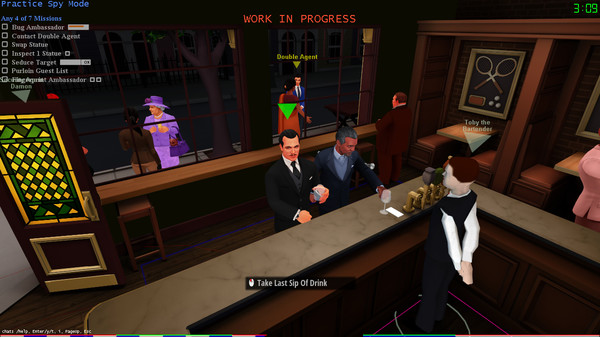

And with the mental and emotional depth Hecker is going for, it will be for all the right reason. From his commitment alone, it’s clear that this is one covert party that will be getting an abnormal amount of attention. There is still lots for Hecker to do before SpyParty begins briefing players on their classified missions, including building an in-game tutorial for players. I’m thinking of doing something crazy with multiple spies by doing drop in/drop out and not notifying the other player someone new dropped in.”Īlthough the game appears to be inherently multiplayer, Hecker said he does plan to build a single-player element too. “There’s going to be multiple spies at the same party, sometime co-operative, sometimes competitive. But another outlook for elite skill that is more interesting than destroying people who don’t know what they’re doing is teaching them to do better at the game.”Īs well as some form of ‘mentoring’ mode, Hecker also has plans to experiment with SpyParty in a number of other ways in the final version. “A lot of players like to go and, as they say, ‘own noobs’. “Games are doing an incredibly bad job of mentoring right now,” he said, and gave the example that new players need to be taught why specific zombies in Left 4 Dead must attack the survivors from behind. Because of the subtly of the gameplay and its two distinct objectives, Hecker is hoping experienced player will teach new entrants to play SpyParty. Hecker has worked on The Sims and Spore, and his design mentality is very much in exploring new ways games can enrich players’ lives. It’s a psychological game of two extremes, so clear goals have been a necessity. The sniper observes all this from afar and has the difficult job of taking a life. He made the point that it is threat of violence from the sniper that adds tension to his game of perception and performance.Īs the spy, you must try to blend into your environment by acting like the other computer-controlled characters around you. ICO’s “revolutionary” handholding mechanic is an example of the kind of connection Hecker is going for.

This desire to create the essence of spy trickery and confidence is at the heart of SpyParty, and introducing subtly to its game mechanics is how. Instead, he’s focusing on the characters, the setting and creating a mood – elements he believes games excel at because of their interactivity. “We’ve been fixed on plot in the fictional aspects of the game industry,” he said. SpyParty isn’t about picking off 007 wannabes or innocent partygoers though – at least not in Hecker’s eyes. When the sniper pulls the trigger on a targeted character, that one act of aggression ends the game. They should use it to punctuate things or add tension,” said Hecker.

“I think games should be more thoughtful about how they use violence. At GameCity in Nottingham, Hecker explained that the game could be seen as an inverse Turing test, which is to say a human is pretending to be a computer to fool another human.


 0 kommentar(er)
0 kommentar(er)
